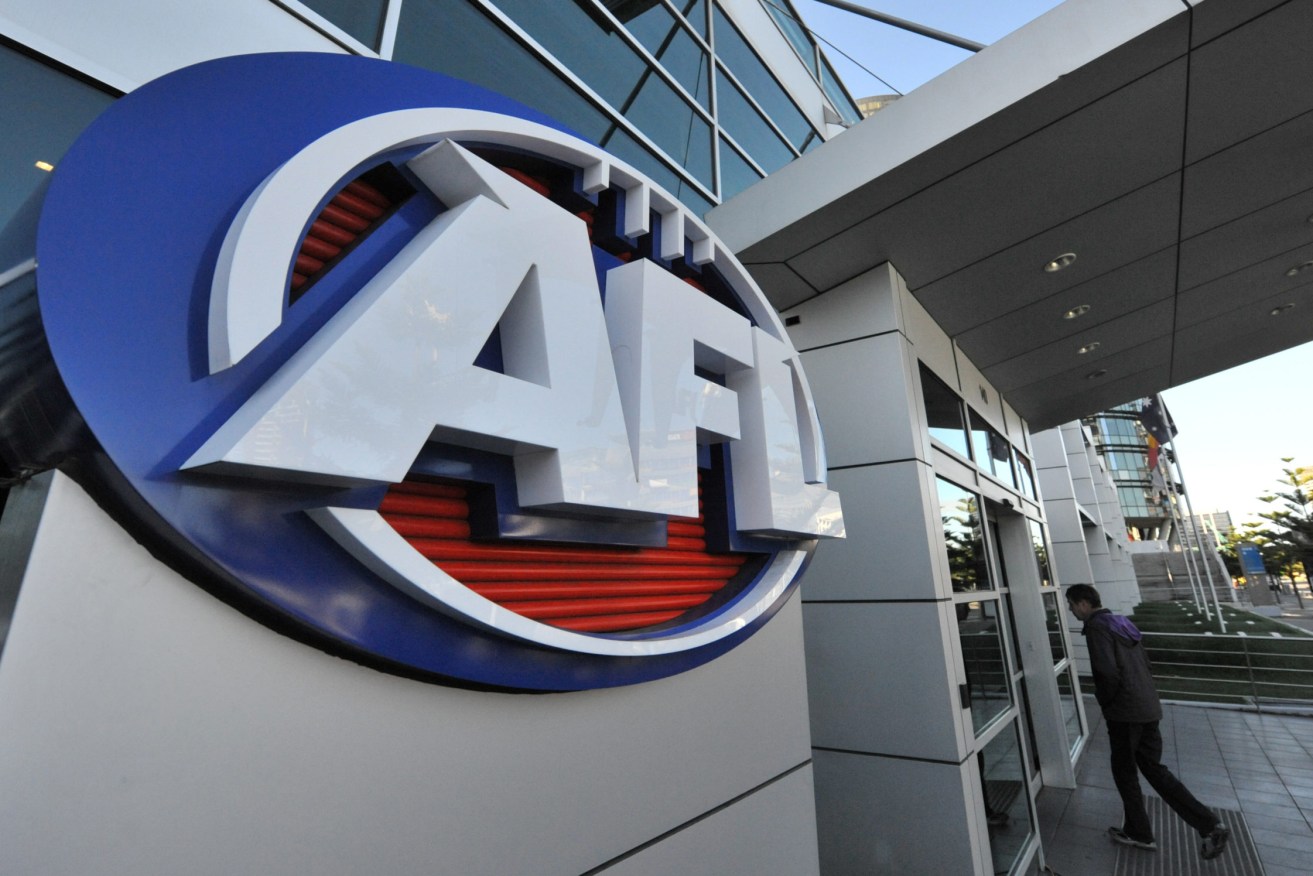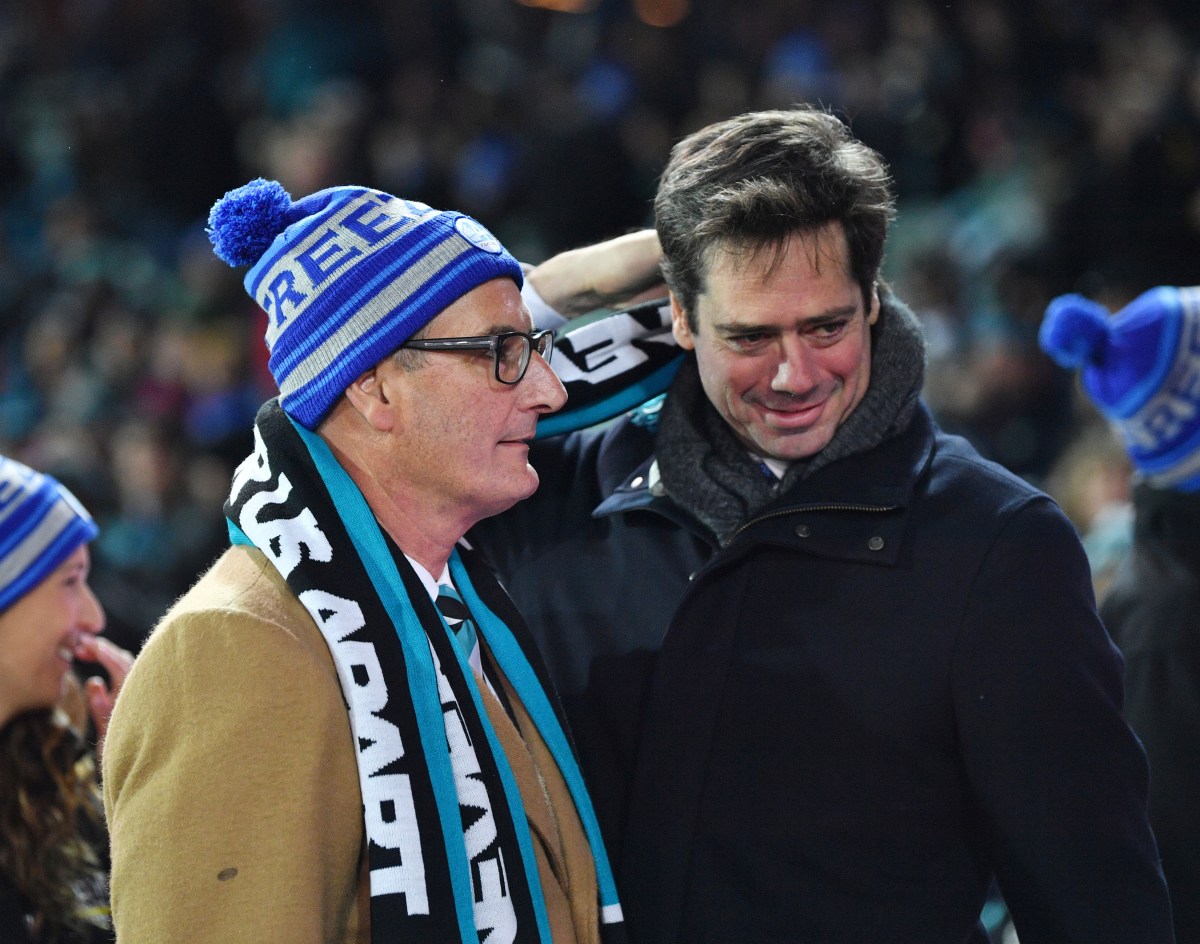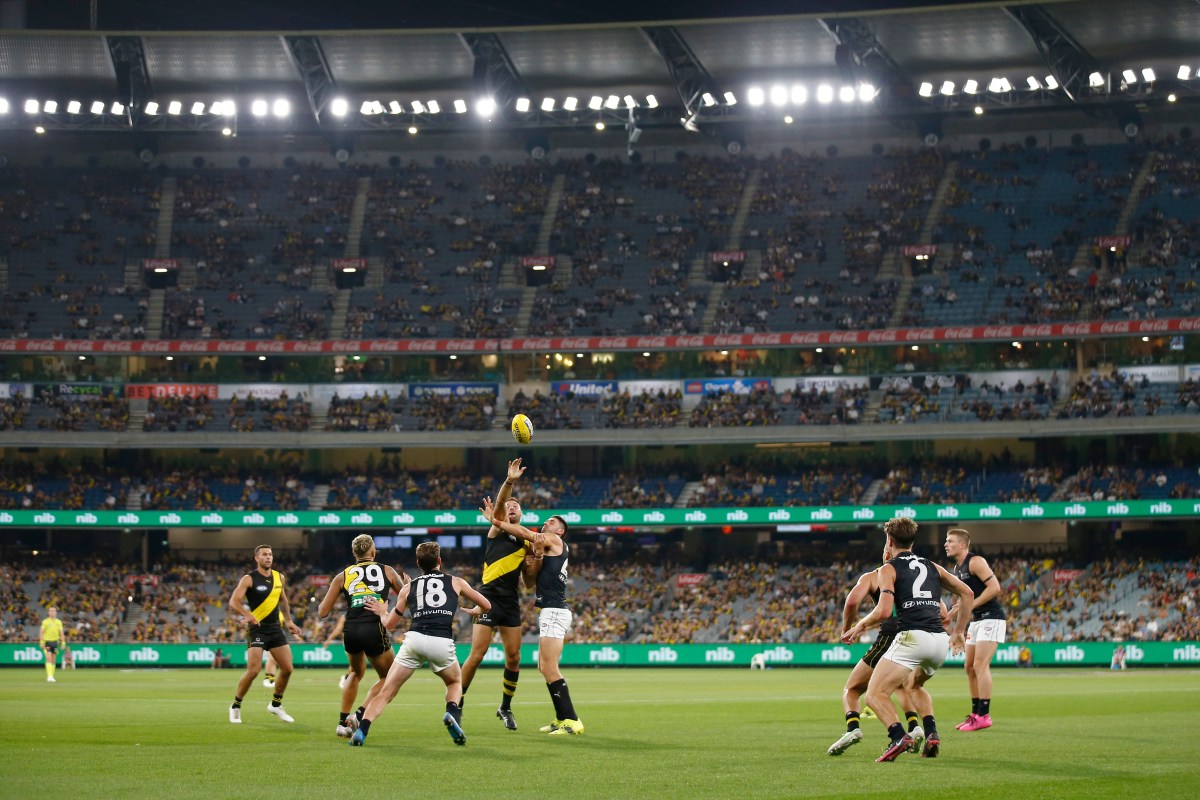AFL Victorian bias: true or false?
John Olsen and David Koch have found common ground in a widely-held belief that the Melbourne-based AFL is biased towards Victorian clubs. But does perception match reality? Michelangelo Rucci reports.

Photo: AAP/Julian Smith
It’s a brave man who bites the hand that feeds him. Adelaide Football Club chairman John Olsen and his Port Adelaide counterpart David Koch are sharpening their teeth to attack the Melbourne-based “totally Victorian-centric AFL”.
Their populist mission – that brings back the era of South Australians wanting to “Kick a Vic” – comes before Olsen and Koch put out their hands to the AFL seeking funding for new club facilities, more attractive match timeslots, representation on the AFL Commission and, in Port Adelaide’s case, an AFLW licence and permission to wear its “prison bars” jumper in Showdowns.
Koch is certainly aware of the danger in attacking “City Hall”, particularly with the push back leading to home matches being assigned to 4.10pm on Sundays in the middle of a cold Adelaide winter. And his club’s line of credit, while carrying at least $12 million in debt, is with the AFL.
But he isn’t fazed.
“Now, I think bugger it,” he said. “We’ve just got to stand up to them. It is getting beyond a joke.”

Port Adelaide president David Koch and AFL CEO Gillon McLachlan. Photo: AAP/David Mariuz
The AFL administration certainly leaves the impression of a subconscious bias towards the 10 Victorian-based teams while the other eight clubs spread across Australia are “out of sight and out of mind”.
South Australian football legend Malcolm Blight, who played and coached for most of his grand career in Victoria, has described the perception as “archaic”.
But fellow Australian Football Hall of Fame legend Leigh Matthews, a Victorian who mentored Brisbane to three consecutive AFL flags from 2001-2003, says a Victorian bias is inevitable in the AFL.
“Of course there is, the VFL became the AFL,” said Matthews. “It’s a Vic-centric competition. It’s like saying the sun is hot.”
So is the perception of a Victorian-biased AFL – a theme that divides even legends of the game – a myth or a reality?
InDaily spoke to five men who played significant roles in Australian football’s transformation from the 1980s – when it was State v State with Origin matches as the pinnacle – to the 21st century with an 18-team national league billed as “Australia’s Game”.
Their response: Olsen and Koch don’t know how good they have it.
Former AFL chief executives Wayne Jackson and Andrew Demetriou, former SANFL president Max Basheer and chief executive Leigh Whicker and former West Coast and Sydney chairman Richard Colless lived the transformation of the Victorian Football League to the Australian Football League.
Colless carries the memory from a club presidents’ meeting with the AFL Commission in 1994 when Adelaide chairman, the late Bob Hammond, waited until the end of the session to grill commission chairman John Kennedy.
“Explain to me why Adelaide is not playing any home-and-away games at the MCG,” said Hammond, who later became an AFL commissioner – the last South Australian in that high office.
Kennedy replied: “Bob, it’s only in September (during finals) that playing on the MCG counts.”
Colless immediately reacted to emphasise Kennedy had missed Hammond’s “legitimate point” – every AFL team deserves the chance every season to experience the peculiar ways of the MCG at least once before finals.
Today, this battle has been won, albeit while committing the AFL grand final to the MCG until at least 2058 in return for $500 million from the Victorian State government. Also, no longer is there a legal block to preliminary finals being moved from the MCG to a non-Victorian venue to reward a team for its higher ranking.
We’ve just got to stand up to them. It is getting beyond a joke.
Basheer, the longest-serving SANFL president with the greatest battle scars with his VFL counterparts, and Whicker attribute the game’s change to a national focus to Ron Evans, the Essendon goalkicking champion who finished his league football career at West Perth. He was AFL Commission chairman from 1998-2007.
“Ron Evans had the greatest understanding of people and the roles they played in the game,” said Whicker.
Demetriou started his rule as AFL chief executive in 2003 with Evans as his chairman. He noted the trust Evans built across Australia, thereby breaking down perceptions of Victorian agendas always over-riding national interests for Australian football.
“Ron was all about, ‘My word is my word’ and he looked people in the eye,” Demetriou told InDaily.
Colless recalls the new, nationally minded VFL that was rebadged AFL in 1990 had to work against decades of bitter jealousies and mistrust that still lingers, as noted with Olsen and Koch.
“The VFL went bankrupt in the mid-1980s,” said Colless. “The South Australians had a better run competition and a strong financial base. But it was still the Victorians calling the shots on a national league.”
Wayne Jackson became the first South Australian – and first non-Victorian – to fill the AFL chief executive seat when he moved from the AFL Commission to the league’s headquarters in 1996, then at the MCG.
“We immediately changed the language – there is no ‘interstate’ club in the national competition,” said Jackson who led the league executive from 1996-2003. The term “interstate club” reaffirms the Victorian themes of the competition when in reality the Melbourne-based Collingwood is an “interstate team” to the West Australians.
Jackson also changed the make-up of the AFL where he found only Victorians on critical committees. Dr Peter Barnes from Port Adelaide joined the medical panel; Crows premiership ruckman David Pittman was added to the AFL tribunal jury; former Adelaide chief executive Bill Sanders led the national review of umpiring; West Coast premiership hero Chris Mainwairing and South Australian football great Neil Kerley became All-Australian selectors.
“We took AFL premiership matches to Darwin and Alice Springs – we thought about national growth rather than just consolidation in Victoria,” Jackson said. “When we employed people, we had a preference for those who had experiences outside Victoria. We made a lot of progress.”
But has this progression to a national game been eroded recently, as Olsen and Koch suggest?
“I don’t see any evidence of that,” said Jackson.
But what of the MCG deal, more so after the game lost nothing by having the AFL grand final at the Gabba in Brisbane last year while Melbourne was in a lockdown by COVID outbreaks?
“The only way you can have the MCG redeveloped to give the grand final a modern, 100,000-seat venue is to guarantee the venue has a long tenure with the grand final,” Jackson said. “It is a commercial agreement.
“And I recall from my time at the AFL, every time we asked the players – it was the MCG for them.”
And the preference shown to Victorian-based teams with prime timeslots, in particular Friday Night Football?
“If you want Fremantle v Adelaide on Friday night, what would the television ratings be like in the biggest market of Victoria? Again, it is a commercial decision,” said Jackson. “The AFL is not Melbourne-centric. It is simply maximising commercial opportunities.”

Richmond v Carlton at the MCG. Photo: AAP/Daniel Pockett
Jackson introduced the “competitive balance fund”, effectively making him “Robin Hood” by taking from the rich clubs that benefitted from the league’s commercial decisions to compensate the poor, such as North Melbourne that pioneered Friday Night Football in the 1980s and ultimately lost the timeslot when it became a popular offering to television executives and the fans.
Demetriou succeeded Jackson and led the AFL when it invested millions in expansion on the Gold Coast and western Sydney rather than commit these funds to boosting Victorian-based clubs. Has he seen a Victorian bias under the leadership of AFL chairman Richard Goyder (a West Australian) and chief executive Gillon McLachlan (a South Australian)?
“That is nonsense; I don’t buy it,” Demetriou told InDaily. “Surely that was debunked when Wayne Jackson changed the AFL, starting with referring to ‘non-Victorian’ rather than ‘interstate’ clubs. He introduced policies to equalise the competition, on and off the field.
“No, the AFL is not Victorian-centric.
“If you started again with a blank sheet of paper, you might not have 10 Victorian teams. But we have a quirky competition – and it is better for that quirkiness.
“It is quite fashionable to beat up that line of the AFL being Victorian-centric. Some people think there are votes to be gained with that argument. But it is not real.”
Perception overwhelms reality when the AFL Commission prepares to embrace former Western Bulldogs president Peter Gordon – a Victorian – as the newest member of Australian football’s most-powerful forum. Olsen questions why South Australia has not had a commissioner since Hammond resigned amid ill health in 2011.
“If,” said Jackson, “you want a South Australian on the AFL Commission, find one and work assiduously to have them elected.”
Basheer would prefer the AFL Commission to resemble the Senate in federal parliament.
“There ought to be a representative from every State,” Basheer said. “Bob Hammond was an ideal commissioner. While he represented the views of South Australia, he also was a fair-minded person who understood the needs of the game and its people well beyond Adelaide.”
Basheer led the SANFL as president from 1978-2003, enduring long battles with the VFL – including the boycott of interstate duels in the 1970s and the attempted luring of the SANFL’s biggest club, Port Adelaide, to an expanding VFL in 1990.
“That was when the game was more biased towards Victoria,” Basheer said. “Today, I see the game is based on a national competition more than ever before. Up to 1990, it was very difficult to deal with the VFL. We were always at loggerheads with the VFL.
“This had changed substantially since 1990.”
Whicker left the SANFL after successfully transferring football from its headquarters in exile at West Lakes back to the traditional home at Adelaide Oval with a $535 million State-funded project heavily influenced by Demetriou.
“And the AFL helped Port Adelaide out of dire financial straits a decade ago,” Whicker said. “There is a lot of shadow boxing going on when you hear club presidents take on the AFL. We have two AFL clubs in South Australia that need to stand on their own feet and get on with life while the AFL makes decisions. Make too many complaints and you will come undone.”
While Koch and Olsen have found rare common ground along the Port Adelaide-Crows divide Bob supporting each other on the supposed Victorian-centric ways of the AFL administration in Melbourne’s Docklands precinct, Colless warns against forming an alliance of non-Victorian clubs.
“You run the risk of always being outvoted – 10-8,” Colless said. “We, as non-Victorian clubs, are also victims of distance. We don’t know each other well because we rarely meet.
“The 10 Victorian-based clubs are not only close to each other, but they also have easy access for the AFL decision makers. Hawthorn coach Alastair Clarkson can meet up with (AFL chief executive) Gillon McLachlan for a cup of coffee … and to talk about changing the holding-the-ball rule. Check how often John Longmire has had a one-on-one session with Gil in his 11 years as Sydney coach.”
The AFL is not Melbourne-centric. It is simply maximising commercial opportunities.
The AFL Commission and executive has even more power for its agenda today after the COVID hit to club finances last year put most of the competition on lifelines to AFL-controlled credit.
“That commercial reality dictates so many AFL decisions,” said Colless. “Can you imagine the AFL doing anything that is commercially disastrous to the Melbourne clubs – or Victoria? They would be skewered by the media in Melbourne.”
One such example would be following European soccer with the Champions League and US football with the Super Bowl by having Olympic-style bidding to host the AFL grand final outside Melbourne.
Colless noted the roadblocks former Sydney chief executive Andrew Ireland found in 2018 when he proposed the AFL grand final become a best-of-three series to afford fairness to non-Victorian clubs, such as Adelaide that lost the 2017 grand final to MCG tenant club Richmond.
“It always frustrates me that we don’t have a level playing field for the most important game of the season,” Colless said. “Andrew Ireland’s proposal for a best-of-three grand final series was interesting. We would have 22 weèks of home-and-away football with carnage by injuries, then three weeks of finals building up to a grand final series that if it gets to the third game we would be all so physically and emotionally drained.
“But we would be doing justice to our wish for a competition that decides the premiership with genuine balance and absolute equity. It is hard to argue against that.”
Since the league expanded from the VFL’s Melbourne-centric roots in 1987 by adding West Coast in Perth and the Brisbane Bears, the competition has lost one of its foundation VFL clubs (Fitzroy that merged with Brisbane at the end of 1996) and added outside Melbourne five clubs – Adelaide (1990), Fremantle (1995), Port Adelaide (1997), Gold Coast (2011) and Greater Western Sydney (2012).
The 10 Victorian-based clubs argue their non-Victorian rivals are better placed with true home-field advantages and less competition for corporate sponsorship in their less-cluttered home States.
Of the 31 premierships carrying the AFL logo since 1990, the spread of flags is – 19 to Victorian-based clubs, 12 to the non-Victorians. From 2001 to 2006, an AFL premiership went to every non-Victorian market – Queensland with Brisbane from 2001-2003; South Australia with Port Adelaide in 2004; New South Wales with Sydney in 2005 and Western Australia with West Coast in 2006.
“And when we expanded to Gold Coast and west Sydney,” Demetriou said, “we were accused of giving those new teams too many recruiting concessions to dominate the league and that we would destroy Sydney. The Swans won the flag in 2012. Competition is good, as it was for Adelaide winning two in a row when Port Adelaide joined the league in 1997.
“Saying the AFL is Victorian-centric is a fashion statement.
“Each time we have expanded the competition it has been with a national objective and in tough times, against a failing Australian economy, the global financial crisis. We were told there would not be enough players and the quality of the competition would diminish.
“But we were led by a chairman (West Australian) Mike Fitzpatrick who saw the big picture of national growth while other sporting codes pulled back with their expansion.
“Is that Victorian-centric?”
A former long-serving player, coach and administrator with South Australian heritage who has worked both in Adelaide and Melbourne answers: “It is not Vic-centric … but it can feel that way sometimes.”




